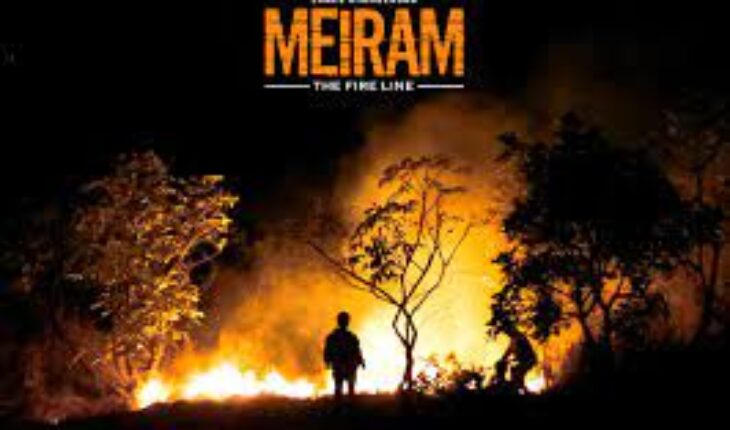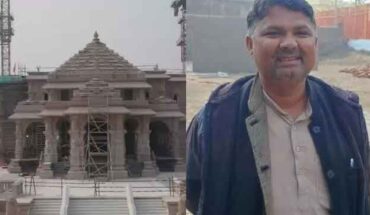A lone poster of James Khagenbam’s documentary film “Meiram: The Fireline” stood boldly, leaning onto a giant banner of Marvel Studio’s “Ant-Man and the Wasp: Quantumania” by the main entrance of Tanthapolis Cinema at Lamphel, Imphal, on Saturday. This juxtaposition highlighted the director’s audacious move to resort to the theatrical release of his non-fiction film. There may be several reasons why people may love fiction films more than documentary films; however, the last evening’s ambiance of the Tanthapolis cinema spoke volumes about the increasing number of audiences who treasure reading the non-fiction texts of Meiram.
The documentary film genre is rooted in the work of John Grierson, its founder. In 1926, he coined the term “documentary” and defined it as the “creative treatment of actuality.” According to Grierson, documentary filmmakers’ pursuit is not simply presenting raw footage of actual events but artistically and compellingly representing reality. And the filmmaker James Khangenbam seems to have infused his creative treatment in Meiram.
“Meiram: The Fireline” focused on protecting a forest in Langol from man-made wildfires. It chronicled the efforts of a team of volunteer firefighters who risked their lives to save a beautiful forest from being obliterated by out-of-control wildfires orchestrated mainly by miscreants. The film captured the intensity and danger of the situation, using captivating visuals to narrate the scale and scope of the wildfire. In addition, scores of supporters of Loiya’s objectives have also been shown. Moreover, it also highlighted the team’s contribution to afforestation and nature protection at their own expense.
Benignly, the filmmaker underlined the state authorities’ incapability to control wildfires and save the forest. Let alone their delinquency. The film showed no forest guards whose primary duty was to monitor for illegal activities and prevent forest fires. Instead, Loiya and Co. are accomplishing what should be done by forest authorities. In one scene, Loiya was on his phone venting anger for not getting assistance tackling wildfire and some religious individuals illegally encroaching into the area to build a gathering hall. The scene emphasized that wildfire was just the tip of the iceberg, and he had to face many other circumstances threatening the forest’s identity in the name of development and religious activities. Various close-up shots of different species of birds and reptiles, juxtaposed with long shots of the forest areas and Loiya, creatively translate into the fact that because of the volunteers, the audience could get a glimpse of this area’s flora and fauna.
The content of the film text is quite relevant, given the climate change the world is facing, though the film’s main focus was on a particular forest area not far from Imphal city. The filmmaker’s choosing this specific place would empower the audience to ponder: If this happens in Imphal, what would be the situation in other far-off districts and forests of the state? Moreover, the visuals in the film range from morning to evening to night. And the visuals of the woods were captivating, showing various times if not all. The stunning visual of clouds covering the valley areas, as seen from the hill range, is not only irresistible, but it also symbolizes isolation and detachment of Langol from the public’s view. And one visual at night shows the wildfire on the left and the glittering night light far in the Imphal valley on the right, signifying and escalating the apprehension that people kept disregarding the protection of nature. The editing technique was creative adequately to stress the core message. Considering the sound effects and score, the filmmaker used ambient sound mostly, and it creatively enhanced the film’s emotional impact. The wind sound carries along the spectators as the film transcends from one weather condition to another and effectively shows time’s passage. Moreover, the roaring fire sounds bolster the intensity of the widespread fire.
Nonetheless, there could be some improvement in the part of a few scenes, where editing was abrupt and offered no connotation of the abruptness. And a few shots, where the ambient sound of the wind was harsh and the scene was calm, it failed to give the intended message to the spectators. But, overall, the filmmaker presents a balanced view of the topic, underscoring different matters that must be addressed. While most people fail to appreciate non-fiction films, given the nature of their storytelling, Meiram pulled it off in captivating its audience through the creative treatment of the subject in 33 minutes.
James Khangenbam has shown, through Moirangthem Loiya and a team of volunteers, the creation of a fireline underscoring the importance of preventing wildfires before they start. And it gently reminds the audience that we all have a role to play in setting up a “fireline” to shield ourselves against human-made ensuing environmental catastrophes.




